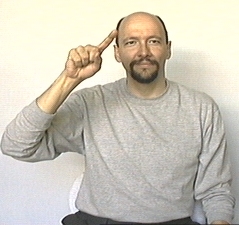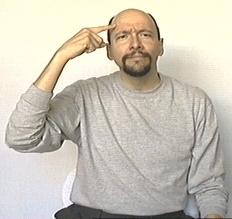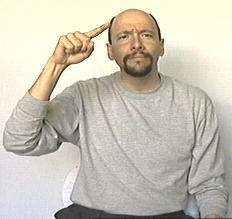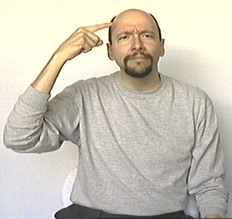American Sign Language: "for"
To do the sign "FOR," touch your forehead and swing the tip of your finger forward.
FOR:
There is a sign known as "FOR-FOR."
The sign "FOR-FOR" is the same as "FOR" except that you use a double motion and you include a "wh?" facial expression.
This sign is interpreted as "What for?" or "Why?"
FOR-FOR:
Sample sentence: "Why are you taking ASL?" = "TAKE-up ASL FOR-FOR?"
Notes and optional reading:
In a message dated 3/20/2011 10:53:33 A.M. Pacific Daylight Time, Chrissunny writes:
Hi, I have a quick question for you - Given the sentence "Tomorrow I am cooking for my friends" would you include the "for" in ASL translation?
Thanks!
Christine
Dear Christine,
The answer is, "It depends."
What constitutes an "appropriate" translation in ASL depends greatly on the context.Let me give you an example in English.
On Saturday, March 19th 2011 Jon Jones, a mixed martial arts competitor asked his coaches:
"We going to catch this guy?"
The context in which the phase was said was important.
Jones and his coaches had just been dropped off at a park in Paterson New Jersey when they heard screaming nearby and saw a perp running away after apparently having smashed a windshield and stolen a GPS. Jones and his coaches were chasing after the perp when Jones asked, 'What do we do? We going to catch this guy?"
He did not ask, "Are we going to catch this guy?" Jones dropped the word "are."
Was it appropriate for Jones to drop the word "are" in his question?
Even without hearing the "state of being" verb "are" -- Jones' coaches understood perfectly what he meant. To have added the word "are" would have taken extra time and effort and contributed little or nothing to the effectiveness of his communication.
Would Jones' college English teacher have approved? I reckon if it was her GPS system that got boosted she wouldn't have cared spit about the missing "be verb" as long as she got back her missing equipment, (and got reimbursed for the windshield).
Ah yes, but after the hubbub died down and the windshield was replaced and it came time to correct Jones's English paper that same instructor might just whip out her red pen and mark an "X" next to that exact same sentence for lack of an "are."
Now back to your announcement of your culinary activities. In all likelihood the sentence "Tomorrow I'm cooking for my friends" would never need to be translated "in real life." Seriously. "Necessary translation" is a process whereby someone is saying something in one language and someone else needs to understand what it means, and thus a third person (or robot, or program) translates it. If two Deaf were chatting in ASL and one wanted to tell the other "Tomorrow I'm cooking for my friends" it is quite likely he/she would sign: TOMORROW, FRIEND COME, I COOK. (Don't get me started on how it is we know "FRIEND" is plural and not singular in this situation. It is a long story and you don't tip well enough.)
Is that the "only" way to sign "Tomorrow I'm cooking for my friends?" Of course not.
You could also sign, "TOMORROW I COOK. WHY?-(rhetorical, eyebrows up), FRIEND COME.
Also more likely than not, such a phrase would show up in real life as part of a two-way conversation wherein someone asked you why you "bought so much food?" You could certainly reply, TOMORROW I COOK MY FRIEND, and it would be obvious that you were not cooking your friends but that you were cooking for your friends.If however you were "translating" a children's book about "trolls" and "giants" and you signed "TOMORROW I COOK MY FRIEND" then it might very well be understood to mean that tomorrow you were indeed going to practice a bit of cannibalism.
The fact is "cook for" is a "Hearing" phrase. To "cook for" means so much more than what it seems on the surface. Really.
Think about it. "Tomorrow I am cooking for my friends," is saying something much more than simply stating that you will be heating up a can of beans that your friends will just happen to eat.
Thus the English phrase, "Tomorrow I am cooking for my friends" really means something more along the lines of, "I'm experiencing quite a bit of excitement and stress because tomorrow an important event is happening. My friends are coming over to my place, (which I've got sooo much to do to get cleaned up and ready) and they will be sampling, judging, and making mental notes regarding my creativity, sensibility, frugality, and talent in regard to food, (as well as table setting). I'm doing this in hopes of creating a social dynamic amongst these people that will result in their having a good time, deepening their friendships, and thinking well of me."
Where does all that extra meaning "go" when we translate it from English to ASL? Most of the time it goes out the window. But such meaning could be included easily enough by inflecting your signs. An extra hold here, a bit more movement there, a lot more facial expression.
The problem we run into is when a teacher gives a student an "assignment" to translate a sentence devoid of context. Then later the teacher or (more likely the) student emails me and asks me what is right.
The only sane answer in most situation is, "it depends."
For what it is worth, (and for a bit of fun), earlier today I asked a fifth generation Coda interpreter how he would sign "Tomorrow I am cooking for friends" and I also asked a trilingual interpreter (ASL/Spanish/English). They both used the sign "FOR" in their initial answers. Of course I didn't tell them the nature of my question or that I was questioning the use of the word "FOR." After they showed me their initial gut response, I then mentioned they question was whether or not they needed the word "FOR" in the sentence. Of course both of them came up with alternate ways to sign the sentence. But does having some other "right" way, make the use of (or lack of the use of) the sign "FOR" wrong? No. It just means that there is more than one right way to sign certain things and what that right way is will depend on context.
For example, there is a certain context that strongly influences the "rightness" of a sign and that is the context of being a student in a classroom. Remember this: Your current ASL teacher is "right" for 15 weeks. If you don't think so, just check your grade at the end of the semester.
Cordially,
--Dr. Bill
QUESTION:
Dear Dr. Bill,
Hi. I know religions aren't all the same signs but several times I have watched interpreters online (I can't understand but want to try.) and I see them sign 'instead of' when the word voiced is 'for'. Other times they use the sign 'for' that is on the forehead.
Thanks!
- Sara C.
ANSWER::
Hello Sara!
The INSTEAD-of sign can be thought of as meaning "in our stead" or "in place of us."
The idea being that when someone says "Jesus died for us" it really means that he died "in our stead" or instead of us.
You could choose to sign "FOR" in that sentence and it would still make sense but by using INSTEAD in that sentence it conveys a more specific (and powerful) meaning.
- Dr. Bill
Want to help support
ASL University? It's easy:
DONATE (Thanks!)
(You don't need a PayPal account. Just look for the credit card
logos and click continue.)
Another way to help is to buy something from the ASLU "Bookstore."
Want even more ASL resources? Visit the "ASL Training Center!" (Subscription
Extension of ASLU)
CHECK IT OUT >
Bandwidth slow? Check out "ASLUniversity.com" (a
free mirror of
Lifeprint.com less traffic, fast access)
VISIT >
You can learn
sign language
(ASL) online at American Sign Language University ™
Lifeprint.com © Dr. William Vicars







